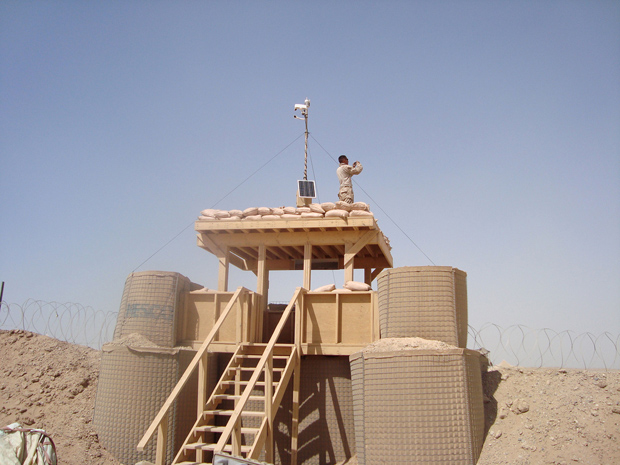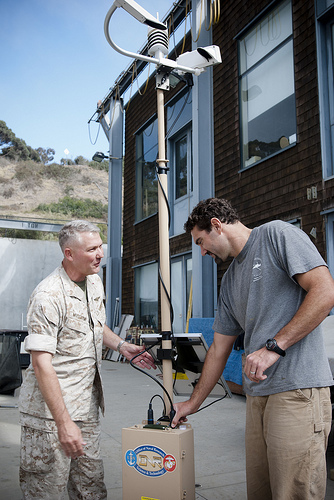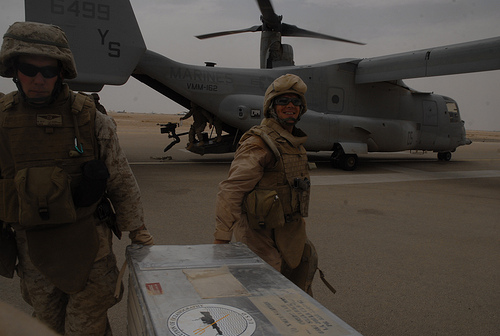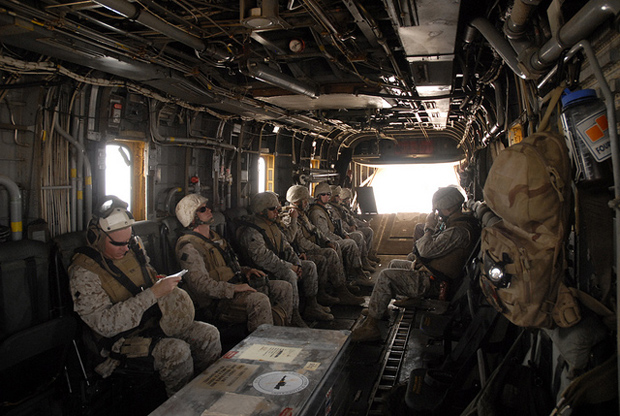By:
- Robert Monroe
Published Date
By:
- Robert Monroe
Share This:
Scripps-U.S. Marine Corps Collaboration Yields Award

Portable Battlefield Weather Station Developed at Scripps Addresses Need for “Environmental Intelligence”
What began as an offhand request over a send-off lunch between a deploying Camp Pendleton Marine and friends at UCSD's Scripps Institution of Oceanography transformed into an award-winning project that has greatly expanded the military’s “environmental intelligence” capabilities in Iraq and Afghanistan battle zones.
The National Defense Industrial Association awarded Marine Corps Chief Warrant Officer Thomas Muschamp the A. Bryan Lasswell Award for his role in developing a portable battlefield weather station known as the Expeditionary Meteorology System, or XMET. Muschamp said, though, that the award is secondary to the benefit it has provided replacing guesswork with knowledge and with improving the safety of troops in the field. He also credited the patriotism and ingenuity of Scripps oceanographer Eric Terrill and his staff for delivering a product that exceeded expectations less than six months after Muschamp first wished aloud for it during a lunch meeting.

USMC CWO3 and Scripps engineer Joel Hazard with an XMET unit on Scripps campus
“They’re doing the right thing with science and technology to help the warfighter,” said Muschamp.
The award is a new chapter in the ongoing relationship Scripps has had with branches of the military since the 1930s. The dialogue that led to XMET began during talks to improve amphibious training exercises at Camp Pendleton through use and integration of a Scripps coastal observation network Terrill manages, but Scripps has also aided a range of military applications ranging from detection of enemy submarines to beach assaults during World War II.
“The cooperation between Scripps Institution of Oceanography and the U.S. Marine Corps is exemplified by the development of the U.S. Marine Corps' Expeditionary Meteorology System, XMET,” said Major General Anthony Jackson, commanding general, Marine Corps Installations West. “When Marine Chief Warrant Officer 3 Thomas Muschamp stated a requirement, Scripps oceanographer Eric Terrill and his staff took up the challenge and delivered a useable product in six months. Cooperation between the American scientific and academic communities, Scripps and UCSD being superb examples, makes for a winning combination that goes beyond military applications.”
The tripod-mounted XMET unit met a need to make battlefield aviation at Forward Operating Bases (FOBs) safer, especially in drought-stricken regions of Iraq and Afghanistan prone to dust storms. Requiring no tools, the rapidly deployable XMET can be set up by two Marines in as little as two minutes. The system can self-orient and includes an optical sensor to assess visibility, a rain gauge, wind and temperature sensors and runs continuously on a solar power-fed battery. It feeds hourly data on weather conditions via Iridium satellite communication to mission planners that use it to greenlight or scuttle combat, humanitarian, or medevac operations. Before such detailed information could only come from observers on the ground.
The timing of the system’s development was fortuitous as it coincided with the placement of caps on the number of troops deployed in Afghanistan set by the Pentagon. Troop reduction at forward operating bases brings a trickle-down cost-savings by reducing the logistics costs of food, water, and supplies.

Deploying XMET during Operation Iraqi Freedom. Photo/CWO3 Thomas Muschamp, US Marine Corps
“Everywhere there’s one of these,” said Muschamp, pointing to an XMET unit during a recent visit to Scripps, “that saves two Marines from deploying to an outlying FOB for each system fielded.”
Terrill credited the Office of Naval Research for supporting the rapid development of XMET, which leveraged an existing ocean weather buoy development effort he had underway. The Navy division funds several research projects led by Terrill as well as by other Scripps researchers, and the partnership allowed his group to be nimble in their support of the Marines. Since 2009, the Marines in Afghanistan have deployed 12 systems throughout the Helmand River Valley. The systems continue to operate at forward operating bases and the accumulated data, available to all branches of the military, is analyzed and used for detailed weather forecasts in combat regions. An excess of 23 years of operational hours now exists on the network and will provide an unprecedented data set to research fine-scale weather patterns in Afghanistan, said Terrill.
Terrill added that no unattended weather-sensing tool had existed in the Marine Corps arsenal, though networked sensors like XMET are becoming common components of science-based earth observational systems. The process that took XMET from the drawing board to the battlefield and its resulting success has effected a new awareness of how unattended environmental sensors and other technologies from the science world could support U.S. expeditionary military campaigns, he said.
“There are a lot of unsung heroes at Scripps who have a role on the field of battle whether they know it or not,” said Muschamp.
The NDIA said the award is given “to San Diego based active duty or civil service person who excelled through technology innovation or in-service engineering in supporting the Navy or Coast Guard Fleet, or Fleet Marine Forces.” It is named for Marine Corps Major A. Bryan Lasswell, a cryptologist stationed at Pearl Harbor who in 1942 deciphered Japanese Navy radio traffic, helping the American victory at Midway Island.

Deploying XMET during Operation Iraqi Freedom. Photo/CWO3 Thomas Muschamp, US Marine Corps
Share This:
You May Also Like
UC San Diego is Strengthening U.S. Semiconductor Innovation and Workforce Development
Technology & EngineeringStay in the Know
Keep up with all the latest from UC San Diego. Subscribe to the newsletter today.



